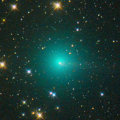
|
Now it is so bright as 7.2 mag (May 25, Marco Goiato). It was origianlly predicted to be 13 mag, but actually, it is much brighter than expected now. The condition is excellent in the Southern Hemisphere, and it keeps visible with binoculars until summer. In the Northern Hemisphere, it is only observable from early June to mid August in the evening low sky.
Date(TT) R.A. (2000) Decl. Delta r Elong. m1 Best Time(A, h)
May 30 15 2.56 -61 14.0 0.942 1.825 137 7.0 22:23 ( 0, -6)
June 6 13 54.31 -50 35.5 0.945 1.812 135 6.9 20:56 ( 1, 5)
|
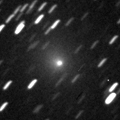
|
Now it is so bright as 8.5 mag (May 26, Juan Jose Gonzalez). Now it is moving southwards very fast. In the Northern Hemisphere, it is getting lower very rapidly, and it will never be observable again after June. In the Southern Hemisphere, it keeps observable for a long time after this in the evening sky.
Date(TT) R.A. (2000) Decl. Delta r Elong. m1 Best Time(A, h)
May 30 7 12.22 10 34.7 1.792 1.223 40 8.4 20:50 (100, 4)
June 6 7 27.64 6 22.7 1.795 1.208 39 8.3 20:56 ( 99, -2)
|
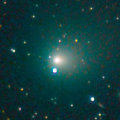
|
It is already so bright as 8.8 mag (May 27, Juan Jose Gonzalez). It will be observable at 8-10 mag in good condition for a long time until late autumn.
Date(TT) R.A. (2000) Decl. Delta r Elong. m1 Best Time(A, h)
May 30 22 43.91 35 24.5 3.265 3.148 74 8.8 3:04 (255, 52)
June 6 22 38.64 35 33.5 3.145 3.140 80 8.7 3:01 (257, 57)
|
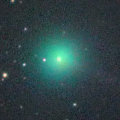
|
Now it is bright as 8.7 mag (May 24, Alexandre Amorim). It keeps 9-10 mag until June. In the Southern Hemisphere, it keeps observable in a good condition for a long time. In the Northern Hemisphere, it will never be observable again.
Date(TT) R.A. (2000) Decl. Delta r Elong. m1 Best Time(A, h)
May 30 1 31.18 -47 48.4 1.047 1.325 79 9.3 3:04 (312,-24)
June 6 2 34.21 -55 14.8 1.063 1.384 83 9.5 3:01 (318,-33)
|
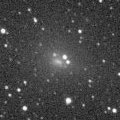
|
Now it is very bright as 9.0 mag (May 27, Juan Jose Gonzalez). It will be bright at 9-10 mag for a long time until autumn.
Date(TT) R.A. (2000) Decl. Delta r Elong. m1 Best Time(A, h)
May 30 21 47.74 -11 21.0 0.999 1.578 103 9.5 3:04 (320, 34)
June 6 22 2.14 -10 35.8 0.960 1.582 106 9.4 3:01 (321, 36)
|

|
Now it is bright as 8.9 mag (May 12, Uwe Pilz). In the Northern Hemisphere, it is getting lower in the evening sky, and will be too low to observe soon. But it will appear in the morning sky again at 12 mag in late August, then it will be fading slowly in the low sky. In the Southern Hemisphere, it is not observable until August. But it keeps observable in good condition for a long time after August.
Date(TT) R.A. (2000) Decl. Delta r Elong. m1 Best Time(A, h)
May 30 5 26.95 40 2.3 2.200 1.319 22 9.4 20:50 (137, 4)
June 6 5 46.55 36 34.6 2.281 1.350 17 9.6 20:56 (137, -1)
|
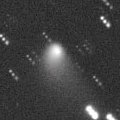
|
Now it is very bright as 9.9 mag (May 22, Marco Goiato). It keeps as bright as 10-11 mag for a long time untio 2010 spring. It is not observable in the Northern Hemisphere now. But it will appear in the morning sky in early October, then it keeps observable at 10 mag in good condition for a long time. In the Southern Hemisphere, it is getting lower rapidly in the evening sky, and will be too low to observe in July.
Date(TT) R.A. (2000) Decl. Delta r Elong. m1 Best Time(A, h)
May 30 7 2.10 -10 14.0 3.233 2.689 49 11.1 20:50 ( 84,-10)
June 6 7 13.74 -8 33.8 3.252 2.648 45 11.1 20:56 ( 89,-13)
|

|
It passed near by the earth in late February, and it reached up to 4.9 mag (Feb. 23, Juan Jose Gonzalez). The coma extended up to 20 arcmin, and the anti-tail was clearly visible. Now it is fading rapidly. It has already faded down to 11.8 mag (May 17, Carlos Labordena). It will be unobservable soon. But it will appear in the morning sky again at 14 mag in August.
Date(TT) R.A. (2000) Decl. Delta r Elong. m1 Best Time(A, h)
May 30 6 44.98 22 10.6 3.147 2.348 31 12.1 20:50 (113, 5)
June 6 6 48.22 22 6.0 3.297 2.425 25 12.3 20:56 (118, 0)
|
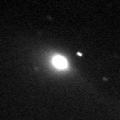
|
It brightened very rapidly, faster than expected, and reached up to 9.3 mag in spring (Mar. 26, Juan Jose Gonzalez). Now it is fading. However, it is still very bright as 9.7 mag (May 26, Juan Jose Gonzalez). But it will be too low to observe in the evening in late June.
Date(TT) R.A. (2000) Decl. Delta r Elong. m1 Best Time(A, h)
May 30 7 18.34 27 12.7 2.300 1.643 39 12.2 20:50 (113, 15)
June 6 7 40.84 26 27.6 2.382 1.693 37 12.5 20:56 (114, 12)
|

|
Now it is very bright as 11.3 mag (May 26, Marco Goiato). It keeps observable until July when it becomes too low in the evening sky, around 12-13 mag for a long time.
Date(TT) R.A. (2000) Decl. Delta r Elong. m1 Best Time(A, h)
May 30 10 9.75 12 59.5 2.118 2.204 81 12.8 20:50 ( 75, 41)
June 6 10 19.87 11 50.3 2.186 2.196 77 12.8 20:56 ( 78, 36)
|
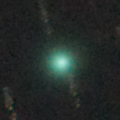
|
It brightened rapidly, and it reached up to 7.5 mag on Apr. 5 (Juan Jose Gonzalez). Now it is appearing in the morning sky again. It is fading now. But it is still very bright as 10.5 mag (May 29, Carlos Labordena). It will be getting higher gradually after this, and it keeps observable until it has gone away. It will be visible visually for some more time.
Date(TT) R.A. (2000) Decl. Delta r Elong. m1 Best Time(A, h)
May 30 23 43.62 30 36.9 1.258 1.210 63 13.1 3:04 (256, 38)
June 6 23 20.95 30 1.2 1.171 1.319 73 13.7 3:01 (262, 47)
|

|
It brightened up to 9.8 mag in December and January (Dec. 28, Juan Jose Gonzalez). Now it is fading, but still bright as 12.5 mag (May 26, Juan Jose Gonzalez). It will be too low to observe in June. However, it will be observable in good condition again in winter at 15 mag. Then it may be still visible visually.
Date(TT) R.A. (2000) Decl. Delta r Elong. m1 Best Time(A, h)
May 30 7 51.23 27 2.4 4.266 3.642 46 13.3 20:50 (109, 21)
June 6 7 59.91 26 5.8 4.388 3.694 41 13.4 20:56 (111, 15)
|

|
The condition of this return is bad, and it has not been observed yet. It will appear in the morning low sky at 13.5 mag in June. Then it will be getting higher gradually while fading slowly.
Date(TT) R.A. (2000) Decl. Delta r Elong. m1 Best Time(A, h)
May 30 2 36.27 21 6.3 2.230 1.390 25 13.4 3:04 (244, 0)
June 6 3 1.32 22 56.3 2.213 1.381 26 13.3 3:01 (243, 1)
|

|
It brightened up to 11.5 mag in last summer (Aug. 4, Marco Goiato). Although it is not observable in the Northern Hemisphere, it keeps observable in good condition for a long time in the Southern Hemisphere. However, no visual observations have been reported since last summer. Recent CCD observations suggest that it is still visible visually around 12-13 mag.
Date(TT) R.A. (2000) Decl. Delta r Elong. m1 Best Time(A, h)
May 30 5 11.59 -43 26.1 3.609 3.327 65 13.5 20:50 ( 61,-46)
June 6 5 21.60 -42 3.2 3.672 3.370 64 13.6 20:56 ( 64,-50)
|

|
Now it is 13.3 mag, still visible visually (May 17, Carlos Labordena). It had been visible visually as bright as 10-11 mag for half a year since 2008 September until 2009 March. However, it has been fainter than 12 mag since April. It will be unobservable in June.
Date(TT) R.A. (2000) Decl. Delta r Elong. m1 Best Time(A, h)
May 30 8 3.98 21 25.0 6.735 6.134 50 14.0 20:50 (102, 20)
June 6 8 8.42 21 7.0 6.819 6.135 44 14.1 20:56 (106, 14)
|
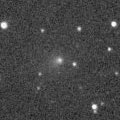
|
Now it is 14.5 mag (May 13, Toru Yusa). It will be brightening rapidly after this, and will be 10 mag in autumn. It keeps observable for a long time until 2010 February. But in the Northern Hemisphere, it will be lower than 20 degree after July when it becomes about 13 mag, then it keeps very low all through the brightest time. It locates a bit higher in the Southern Hemisphere.
Date(TT) R.A. (2000) Decl. Delta r Elong. m1 Best Time(A, h)
May 30 12 19.84 0 52.3 1.286 1.951 115 14.5 20:50 ( 27, 53)
June 6 12 21.02 0 19.0 1.311 1.906 109 14.3 20:56 ( 38, 49)
|

|
Now it is 12.9 mag and visible visually (May 2, Juan Jose Gonzalez). It will brighten up to 12-13 mag in 2010 summer. In 2009, it keeps observable in good condition until summer.
Date(TT) R.A. (2000) Decl. Delta r Elong. m1 Best Time(A, h)
May 30 11 53.03 11 40.2 2.501 2.930 104 14.4 20:50 ( 46, 59)
June 6 11 55.27 10 51.8 2.571 2.910 99 14.4 20:56 ( 56, 53)
|

|
It reached to 10.9 mag in May (May 11, Marco Goiato). It is fading slowly. Now it is 14.0 mag (Apr. 28, Martin Lehky), still visible visually. It keeps bright as 13-14 mag for a long time after this until summer.
Date(TT) R.A. (2000) Decl. Delta r Elong. m1 Best Time(A, h)
May 30 16 24.25 37 3.5 3.660 4.274 121 14.4 23:51 (180, 88)
June 6 16 19.72 37 26.1 3.735 4.323 119 14.5 23:19 (180, 88)
|

|
It brightened much faster than expected, and reached up to 8.4 mag (Jan. 30, Juan Jose Gonzalez). It was very large and visible through binoculars. Now it is fading rapidly. But it is still bright as 12.3 mag (May 17, Carlos Labordena). It is getting lower gradually in the evening sky, and will be too low to observe in July.
Date(TT) R.A. (2000) Decl. Delta r Elong. m1 Best Time(A, h)
May 30 9 38.11 9 59.5 1.960 1.959 74 14.6 20:50 ( 78, 33)
June 6 9 53.24 8 52.1 2.070 2.006 72 14.9 20:56 ( 80, 29)
|
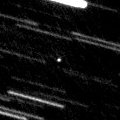
|
It passes the perihelion in June, and brightens up to 13.5 mag. But it is not observable, too close to the sun.
Date(TT) R.A. (2000) Decl. Delta r Elong. m1 Best Time(A, h)
May 30 5 11.06 21 32.5 1.642 0.668 10 15.4 20:50 (127,-11)
June 6 5 36.94 20 50.2 1.476 0.504 9 14.6 20:56 (127,-13)
|
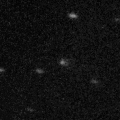
|
Now it is 14.6 mag, already visible visually (May 27, Juan Jose Gonzalez). It will brighten rapidly after this, and it is expected to be observable at 10-11 mag in a good condition for a long time from summer to winter.
Date(TT) R.A. (2000) Decl. Delta r Elong. m1 Best Time(A, h)
May 30 22 17.69 -8 10.0 1.333 1.747 95 15.3 3:04 (310, 32)
June 6 22 35.74 -7 23.2 1.227 1.692 97 15.0 3:01 (311, 34)
|

|
Now it is 13.7 mag (Apr. 21, Juan Jose Gonzalez). It had been bright and visible visually around 13 mag from spring to autumn in 2008. It will be visible visually at 14 mag again until summer.
Date(TT) R.A. (2000) Decl. Delta r Elong. m1 Best Time(A, h)
May 30 13 32.43 37 58.1 6.263 6.639 107 15.1 20:59 (180, 87)
June 6 13 26.52 37 43.5 6.378 6.665 102 15.1 20:56 (116, 83)
|
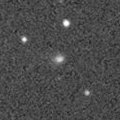
|
It has brightened up to 14 mag in outburst in 2008 August. It has not been observable for a long time, but it is appearing in the morning sky. Now it is bright as 15.4 mag (May 8, Ken-ichi Kadota), brighter than originally expected.
Date(TT) R.A. (2000) Decl. Delta r Elong. m1 Best Time(A, h)
May 30 21 18.39 -28 28.0 2.386 2.957 114 15.2 3:04 (335, 22)
June 6 21 22.19 -29 29.4 2.315 2.964 120 15.1 3:01 (340, 23)
|
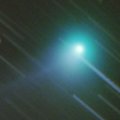
|
It reached to 6.3 mag in September in the southern sky (Sept. 4, Marco Goiato). Now it is fading. It has already faded down to 16.2 mag (May 8, Ken-ichi Kadota). It keeps observable in the northern sky while fading gradually. In the Southern Hemisphere, it will never be observable again.
Date(TT) R.A. (2000) Decl. Delta r Elong. m1 Best Time(A, h)
May 30 1 1.26 78 58.0 3.886 3.520 61 15.1 3:04 (194, 36)
June 6 1 34.77 80 25.7 3.968 3.596 61 15.3 3:01 (192, 35)
|
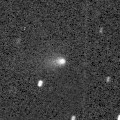
|
Now it is visible visually at 13.6 mag (Apr. 23, Mitsunori Tsumura). It will keep 14-15 mag for a while. But it will be getting lower rapidly after this, and will be too low to observe in July.
Date(TT) R.A. (2000) Decl. Delta r Elong. m1 Best Time(A, h)
May 30 11 33.51 0 34.5 1.845 2.325 105 15.2 20:50 ( 42, 47)
June 6 11 37.05 -0 56.3 1.921 2.320 99 15.2 20:56 ( 49, 41)
|

|
It brightened up to 12.7 mag in 2008 spring (Apr. 12, Marco Goiato). But it faded down to 14.9 mag in July (July 22, Mitsunori Tsumura). In the Southern Hemisphere, it will be observable in good condition after this. It will never be observable again in the Northern Hemisphere.
Date(TT) R.A. (2000) Decl. Delta r Elong. m1 Best Time(A, h)
May 30 20 20.94 -54 13.9 3.356 4.033 125 15.4 3:04 (353, 0)
June 6 20 19.31 -54 53.8 3.344 4.077 130 15.4 3:01 (357, 0)
|
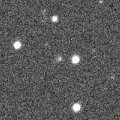
|
Now it is 16.3 mag (May 8, Ken-ichi Kadota). It will brighten up to 15 mag in 2009 and 2010, and will be observable for a long time in good condition.
Date(TT) R.A. (2000) Decl. Delta r Elong. m1 Best Time(A, h)
May 30 21 16.46 48 0.9 2.951 3.037 85 15.7 3:04 (228, 67)
June 6 21 1.96 50 56.7 2.855 3.010 88 15.6 3:01 (211, 70)
|
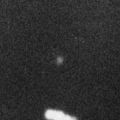
|
It has not been observed since January, but now it is getting higher gradually in the morning sky. It keeps observable in good condition at 15 mag until late autumn.
Date(TT) R.A. (2000) Decl. Delta r Elong. m1 Best Time(A, h)
May 30 0 38.40 6 0.2 4.376 3.924 57 15.6 3:04 (273, 15)
June 6 0 41.54 7 30.0 4.275 3.918 62 15.6 3:01 (275, 20)
|

|
Now it is 14.5 mag and visible visually (Mar. 22, Juan Jose Gonzalez). It will be getting lower in the evening sky after this, and will be too low to observe in July.
Date(TT) R.A. (2000) Decl. Delta r Elong. m1 Best Time(A, h)
May 30 9 33.76 20 57.2 3.772 3.564 70 15.9 20:50 ( 90, 38)
June 6 9 40.22 20 18.3 3.862 3.563 65 16.0 20:56 ( 93, 32)
|

|
It has not been observed since January, but it must have already brightened up to 16.5 mag. It is expected to reach up to 12 mag in 2012, and to be observable visually at 12-13 mag for a long time from 2011 to 2013. In 2009, it is observable in good condition at 16 mag from summer to autumn. In the Northern Hemisphere, the comet will be low around its brightest seasons.
Date(TT) R.A. (2000) Decl. Delta r Elong. m1 Best Time(A, h)
May 30 22 57.57 5 56.9 9.186 9.080 80 16.4 3:04 (290, 35)
June 6 22 56.70 6 3.9 9.029 9.043 87 16.3 3:01 (294, 40)
|

|
It passed near by the earth in April. It brightened up to 14.3 mag and became visible visually (Apr. 22, Alan Hale). It moves southward very rapidly, and it will locate very low after late May in the Northern Hemisphere. The ephemeris says that it will be fading after this, and will be fainter than 18 mag in August. But actually, it has not started fading after the perihelion passage. It is still bright as 13.8 mag (May 2, Juan Jose Gonzalez).
Date(TT) R.A. (2000) Decl. Delta r Elong. m1 Best Time(A, h)
May 30 23 12.00 -27 44.8 0.452 1.115 90 16.4 3:04 (313, 9)
June 6 23 22.22 -31 39.4 0.485 1.173 96 16.6 3:01 (318, 8)
|
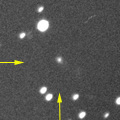
|
Now it is 16.6 mag (Apr. 15, Ken-ichi Kadota). It will reach to 15 mag in 2010. It keeps observable for a long time after this in the Northern Hemisphere.
Date(TT) R.A. (2000) Decl. Delta r Elong. m1 Best Time(A, h)
May 30 15 16.41 5 16.9 5.046 5.929 147 16.7 22:43 ( 0, 60)
June 6 15 13.42 5 54.9 5.062 5.895 141 16.7 22:13 ( 0, 61)
|
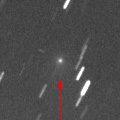
|
It was discovered at 15.5 mag in spring (Mar. 20, R. H. McNaught). Fading now. But it is still 16.2 mag (May 22, Ken-ichi Kadota), brighter than this ephemeris.
Date(TT) R.A. (2000) Decl. Delta r Elong. m1 Best Time(A, h)
May 30 13 47.70 -6 2.0 2.349 3.179 138 17.1 21:15 ( 0, 49)
June 6 13 44.14 -3 55.5 2.483 3.230 129 17.3 20:56 ( 5, 51)
|
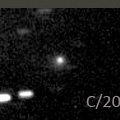
|
It reached up to 16.4 mag in spring (Mar. 14, Ken-ichi Kadota). It will be fading after this, and will be fainter than 18 mag in July.
Date(TT) R.A. (2000) Decl. Delta r Elong. m1 Best Time(A, h)
May 30 13 51.55 31 38.1 2.757 3.313 114 17.1 21:18 ( 0, 86)
June 6 13 38.05 29 44.5 2.870 3.344 109 17.2 20:56 ( 38, 83)
|
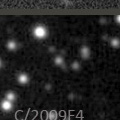
|
It will reach up to 14-15 mag from 2011 to 2012. Now it is 17.3 mag (May 1, Ken-ichi Kadota), and locates low in the south.
Date(TT) R.A. (2000) Decl. Delta r Elong. m1 Best Time(A, h)
May 30 15 14.29 -24 57.9 7.619 8.593 162 17.3 22:41 ( 0, 30)
June 6 15 10.57 -25 3.2 7.622 8.558 155 17.2 22:10 ( 0, 30)
|
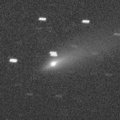
|
It reached up to 9.6 mag in summer (Aug. 2, Juan Jose Gonzalez). Now it is fading. It has already faded down to 16.7 mag (May 2, Ken-ichi Kadota). It keeps observable in good condition until June when it becomes fainter than 18 mag.
Date(TT) R.A. (2000) Decl. Delta r Elong. m1 Best Time(A, h)
May 30 12 27.71 31 31.1 2.857 3.219 101 17.3 20:50 ( 76, 78)
June 6 12 28.45 30 1.3 2.981 3.263 96 17.5 20:56 ( 81, 71)
|

|
Now it is 18.3 mag (May 21, Sierra Stars Observatory). The condition is good in this apparition. It will approach to the earth down to 0.38 A.U., and will be observable in good condition at 16.5 mag in November. It keeps observable until that time after this. But it locates somewhat low in the Northern Hemisphere.
Date(TT) R.A. (2000) Decl. Delta r Elong. m1 Best Time(A, h)
May 30 17 21.70 -24 41.5 0.968 1.970 167 17.9 0:53 ( 0, 30)
June 6 17 12.45 -24 22.4 0.899 1.913 175 17.4 0:16 ( 0, 31)
|

|
It was observed bright at 16.5-17 mag from late 2006 to early 2007. However, it is fading after that, although it is getting closer to the sun. It was so faint as 19.4 mag around the perihelion passage in 2008 spring (Mar. 10, Mitsunori Tsumura). Now it is extremely faint as 21.2 mag (Apr. 20, J. V. Scotti). This comet was observed so faint around the perihelion passage in the previous apparition at the discovery. It faded out before the perihelion passage again in this apparition.
Date(TT) R.A. (2000) Decl. Delta r Elong. m1 Best Time(A, h)
May 30 11 22.06 22 15.0 4.321 4.500 93 22.8 20:50 ( 72, 61)
June 6 11 24.52 21 37.8 4.431 4.510 87 22.9 20:56 ( 78, 54)
|
|
![]()
 C/2007 G1 ( LINEAR )
C/2007 G1 ( LINEAR ) 29P/Schwassmann-Wachmann 1
29P/Schwassmann-Wachmann 1 88P/Howell
88P/Howell 65P/Gunn
65P/Gunn C/2006 Q1 ( McNaught )
C/2006 Q1 ( McNaught ) 144P/Kushida
144P/Kushida (3200) Phaethon
(3200) Phaethon 217P/2009 F3 ( LINEAR )
217P/2009 F3 ( LINEAR ) C/2005 L3 ( McNaught )
C/2005 L3 ( McNaught ) 199P/2008 G2 ( Shoemaker 4 )
199P/2008 G2 ( Shoemaker 4 ) C/2008 A1 ( McNaught )
C/2008 A1 ( McNaught ) 77P/Longmore
77P/Longmore C/2007 B2 ( Skiff )
C/2007 B2 ( Skiff ) C/2008 N1 ( Holmes )
C/2008 N1 ( Holmes ) C/2008 P1 ( Garradd )
C/2008 P1 ( Garradd ) 74P/Smirnova-Chernykh
74P/Smirnova-Chernykh C/2006 S3 ( LONEOS )
C/2006 S3 ( LONEOS ) 209P/2008 X2 ( LINEAR )
209P/2008 X2 ( LINEAR ) C/2008 FK75 ( Lemmon-Siding Spring )
C/2008 FK75 ( Lemmon-Siding Spring ) C/2009 F5 ( McNaught )
C/2009 F5 ( McNaught ) C/2008 Q1 ( Maticic )
C/2008 Q1 ( Maticic ) C/2009 F4 ( McNaught )
C/2009 F4 ( McNaught ) 19P/Borrelly
19P/Borrelly 107P/(4015) Wilson-Harrington
107P/(4015) Wilson-Harrington 173P/2005 T1 ( Mueller 5 )
173P/2005 T1 ( Mueller 5 )![]()


































